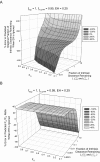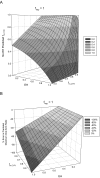Impact of ignoring extraction ratio when predicting drug-drug interactions, fraction metabolized, and intestinal first-pass contribution
- PMID: 20724498
- PMCID: PMC2967394
- DOI: 10.1124/dmd.110.034736
Impact of ignoring extraction ratio when predicting drug-drug interactions, fraction metabolized, and intestinal first-pass contribution
Abstract
Many mathematical models for in vitro to in vivo prediction of drug-drug interactions (DDIs) of orally administered victim drugs have been developed. However, to date, none of these models have been applicable to all intravenously administered victim drugs. We derived and conducted a sensitivity/error analysis of a modification to the existing multiple mode interaction prediction model such that it is applicable to all intravenously administered victim drugs. Using this model we showed that ignoring the hepatic extraction ratio (EH) (as low as 0.3) of intravenously administered victim drugs can result in 1) substantial underestimation of f(m, CYPi) (the fraction of hepatic clearance of the victim drug via a given enzymatic pathway) and 2) error in dissecting the contribution of intestinal and hepatic components of DDIs for orally administered drugs. Using this model we describe DDI boundaries (degree of inhibition or induction) at which ignoring the EH of commonly used victim drugs results in ≥30% error in the predicted area under the concentration-time curve (AUC) ratio or contribution of intestinal interaction to a DDI (CYP3A probes only). For the most widely used victim drug midazolam, these boundaries for AUC ratio are net inhibition (I/K(i) or λ/k(deg)) ≥1.3 or fold induction ≥2.1; for intestinal contribution the boundaries are 0.37 and 1.5, respectively. To accurately predict the intravenous AUC ratio, intestinal contribution, or f(m, CYPi) 1) for all induction DDIs irrespective of EH of the victim drug and 2) for modest to potent inhibition DDIs even when the EH is moderate (≥0.3), we propose that our model be used.
Figures



Similar articles
-
Critical Impact of Drug-Drug Interactions via Intestinal CYP3A in the Risk Assessment of Weak Perpetrators Using Physiologically Based Pharmacokinetic Models.Drug Metab Dispos. 2020 Apr;48(4):288-296. doi: 10.1124/dmd.119.089599. Epub 2020 Jan 29. Drug Metab Dispos. 2020. PMID: 31996361
-
Maximal inhibition of intestinal first-pass metabolism as a pragmatic indicator of intestinal contribution to the drug-drug interactions for CYP3A4 cleared drugs.Curr Drug Metab. 2007 Oct;8(7):685-93. doi: 10.2174/138920007782109805. Curr Drug Metab. 2007. PMID: 17979656 Review.
-
Simulations of Cytochrome P450 3A4-Mediated Drug-Drug Interactions by Simple Two-Compartment Model-Assisted Static Method.J Pharm Sci. 2017 May;106(5):1426-1438. doi: 10.1016/j.xphs.2017.01.008. Epub 2017 Jan 13. J Pharm Sci. 2017. PMID: 28089686
-
Physiologically based pharmacokinetic model of mechanism-based inhibition of CYP3A by clarithromycin.Drug Metab Dispos. 2010 Feb;38(2):241-8. doi: 10.1124/dmd.109.028746. Epub 2009 Nov 2. Drug Metab Dispos. 2010. PMID: 19884323 Free PMC article.
-
Predicting drug-drug interactions involving the inhibition of intestinal CYP3A4 and P-glycoprotein.Curr Drug Metab. 2010 Nov;11(9):762-77. doi: 10.2174/138920010794328922. Curr Drug Metab. 2010. PMID: 21189139 Review.
Cited by
-
Inhibition of human CYP3A4 and CYP3A5 enzymes by gomisin C and gomisin G, two lignan analogs derived from Schisandra chinensis.Fitoterapia. 2017 Jun;119:26-31. doi: 10.1016/j.fitote.2017.03.010. Epub 2017 Mar 24. Fitoterapia. 2017. PMID: 28344076 Free PMC article.
-
Lack of indinavir effects on methadone disposition despite inhibition of hepatic and intestinal cytochrome P4503A (CYP3A).Anesthesiology. 2012 Feb;116(2):432-47. doi: 10.1097/ALN.0b013e3182423478. Anesthesiology. 2012. PMID: 22273859 Free PMC article.
-
Complex drug interactions of HIV protease inhibitors 1: inactivation, induction, and inhibition of cytochrome P450 3A by ritonavir or nelfinavir.Drug Metab Dispos. 2011 Jun;39(6):1070-8. doi: 10.1124/dmd.110.037523. Epub 2011 Mar 15. Drug Metab Dispos. 2011. PMID: 21406602 Free PMC article. Clinical Trial.
-
Evaluation of drug-drug interactions for oncology therapies: in vitro-in vivo extrapolation model-based risk assessment.Br J Clin Pharmacol. 2015 Jun;79(6):946-58. doi: 10.1111/bcp.12563. Br J Clin Pharmacol. 2015. PMID: 25443889 Free PMC article.
-
In vitro inhibitory effects of kaempferitrin on human liver cytochrome P450 enzymes.Pharm Biol. 2019 Dec;57(1):571-576. doi: 10.1080/13880209.2019.1656257. Pharm Biol. 2019. PMID: 31456483 Free PMC article.
References
-
- Abernethy DR, Greenblatt DJ, Shader RI. (1984) Imipramine-cimetidine interaction: impairment of clearance and enhanced absolute bioavailability. J Pharmacol Exp Ther 229:702–705 - PubMed
-
- Abernethy DR, Kaminsky LS, Dickinson TH. (1991) Selective inhibition of warfarin metabolism by diltiazem in humans. J Pharmacol Exp Ther 257:411–415 - PubMed
-
- Ciraulo DA, Barnhill J, Boxenbaum H. (1985) Pharmacokinetic interaction of disulfiram and antidepressants. Am J Psychiatry 142:1373–1374 - PubMed
-
- Ciraulo DA, Barnhill JG, Jaffe JH. (1988) Clinical pharmacokinetics of imipramine and desipramine in alcoholics and normal volunteers. Clin Pharmacol Ther 43:509–518 - PubMed
-
- Ernest CS, 2nd, Hall SD, Jones DR. (2005) Mechanism-based inactivation of CYP3A by HIV protease inhibitors. J Pharmacol Exp Ther 312:583–591 - PubMed
Publication types
MeSH terms
Substances
Grants and funding
LinkOut - more resources
Full Text Sources
Medical

